Whether you are baking a pie for the upcoming holidays or just have the urge to bake a pie, you may be wondering at what temperature you should bake your crust. If so, you've come to the right place. We've researched the topic in-depth and have the temperature, or should we say, range of temperatures, for baking a pie crust.
It would be best if you baked a pie crust at a temperature between 350ºF and 475ºF. This might seem like a wide range, and it is, but pie crusts can be successfully baked anywhere between those two temperatures. If you have a store-bought pie crust, it will often instruct you to bake the crust anywhere between 375ºF to 450ºF.
So, we know that might seem a little vague, which is why you should keep reading as we elaborate on this further. We'll discuss some different pie crust recipes and the temperature they suggest for baking your crust. Additionally, we'll answer some other questions you might have about baking a pie crust.
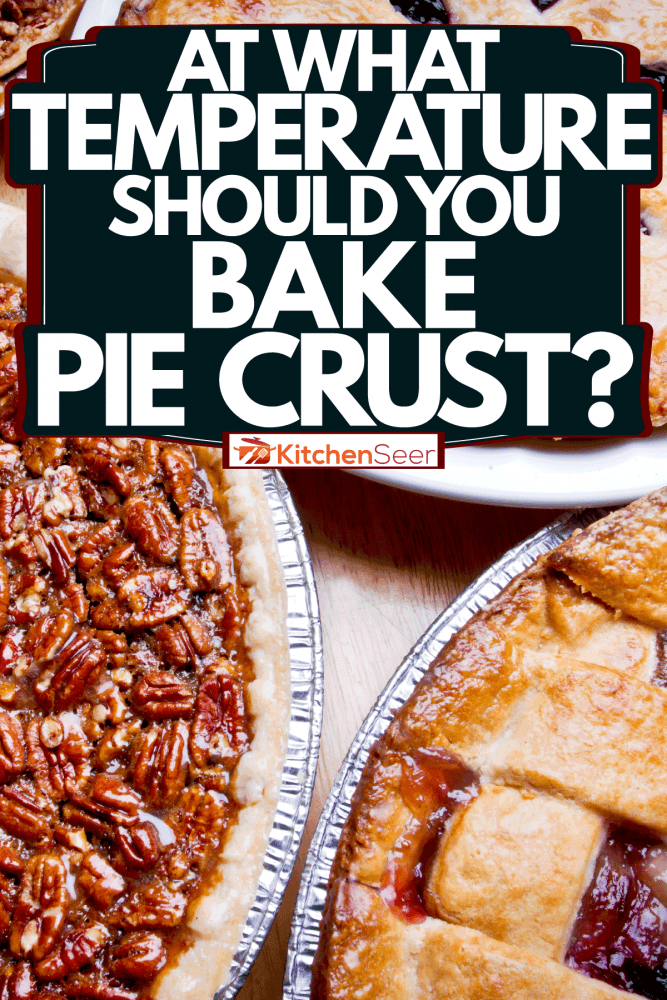
Baking A Pie Crust: 'Low and Slow' or 'High and Fast?'
Generally speaking, the range of temperatures for baking a pie crust seems to be so vast because there are two main techniques in play. Those techniques are baking the crust low and slow or high and fast, and it's exactly how it sounds.
One involves baking the pie crust at a low temperature for a long period of time. The other involves baking the crust at a high temperature quickly. There is also a third method that involves a little of both.
Low and Slow
Though more time-consuming, there are certainly some benefits to baking your pie crust at a lower heat for a longer period of time. Baking your pie crust at a lower temperature prevents the crust from shrinking. It also helps prevent air bubbles from forming throughout your crust. One recipe suggests blind baking a pie crust at 350ºF for an hour.
High and Fast
If you are short on time, you can bake your pie crust at a higher temperature for a shorter amount of time. Typically when doing this method, you will bake the pie crust at a temperature higher than 400ºF for anywhere between 8 to 30 minutes until the pie crust is a golden color. For example, one Betty Crocker recipe instructs you to bake the pie crust at 475ºF for 8 to 10 minutes.
Both
Some methods will instruct you to bake the pie crust at a high temperature to begin with. Then the method will have you decrease the oven temperature to finish out the bake.
Baking A Pie Crust: Blind Baking
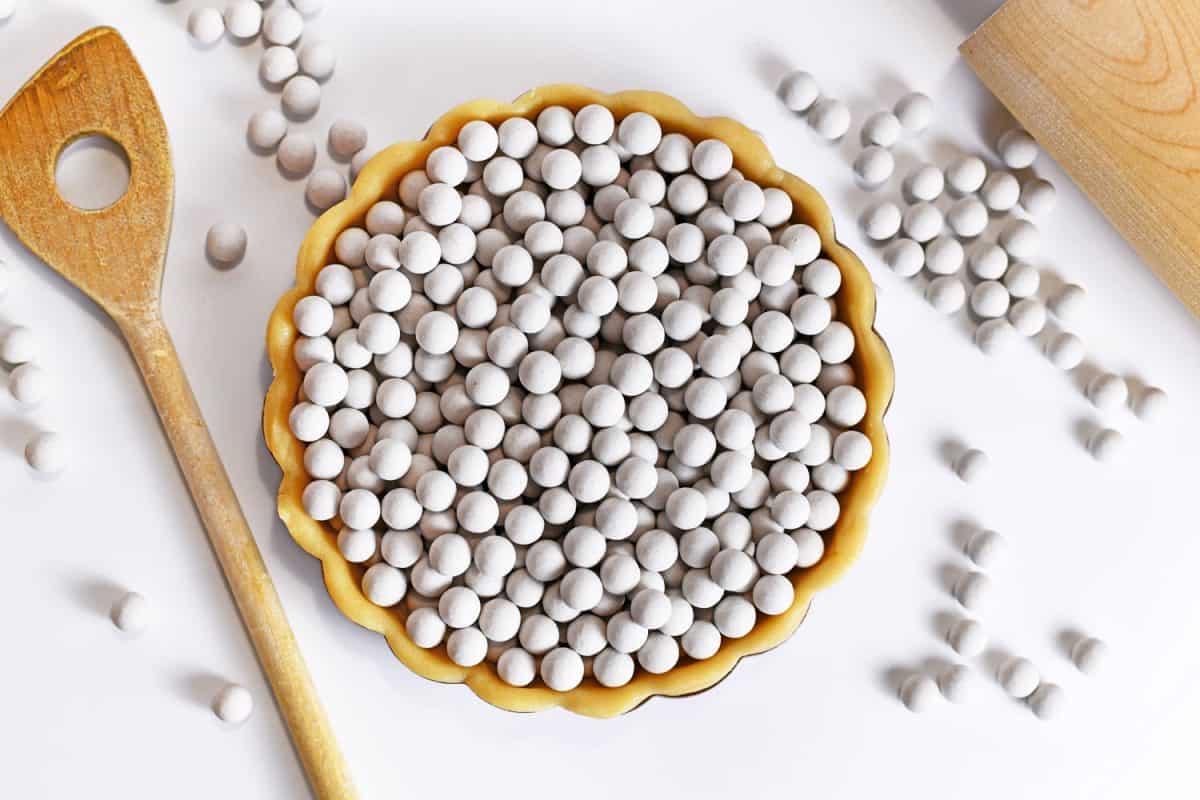
The two techniques we mentioned above involve baking the pie crust's blind. No, this doesn't mean you're going to bake them without looking at them. It means you will be baking, or pre-baking, the pie crust unfilled. Baking a pie crust blind usually involves using weights, like in the image above, to help prevent the pastry from puffing up.
There are pie weights available to buy, or you can use dried beans, sugar, or rice. First, line the dough with parchment paper or foil, and then fill the lining with your choice of weight. Using weights to blind bake will help prevent the pastry from shrinking while it bakes.
Click here to see pie weights on Amazon.
Can I Blind Bake a Pie Crust without Weights?
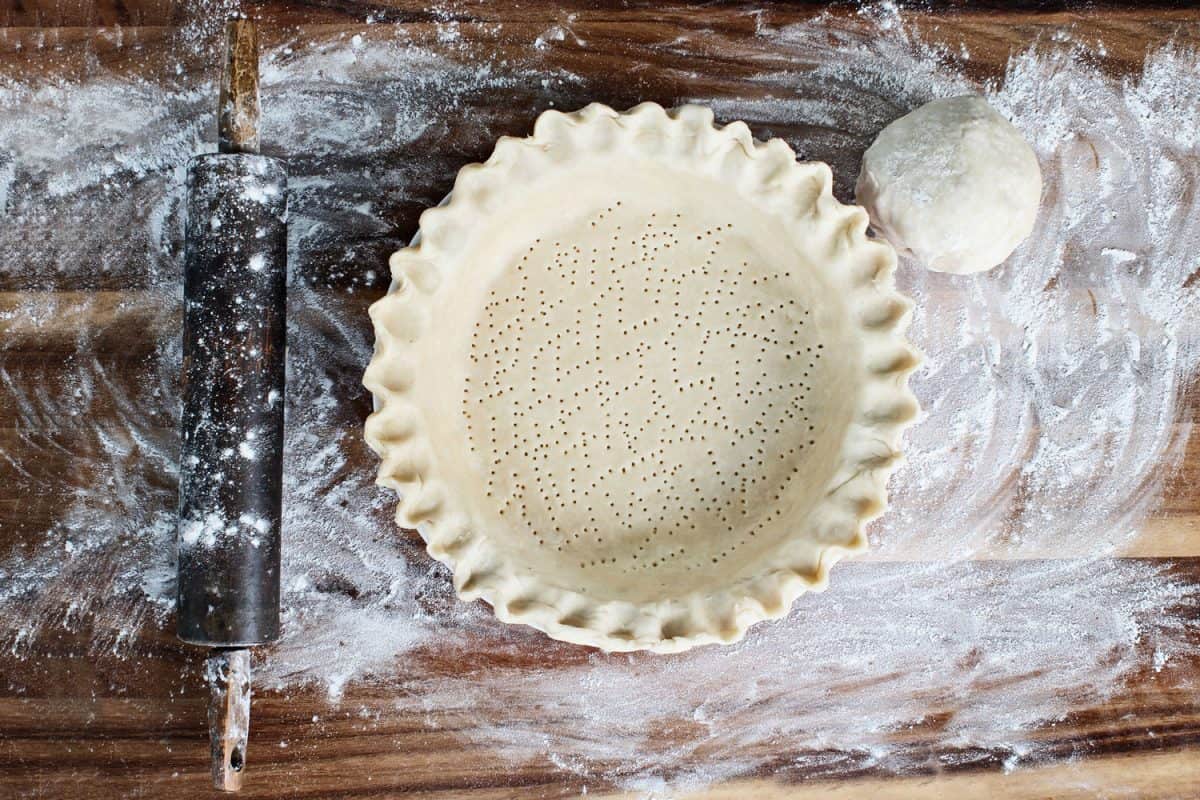
You can blind bake a pie crust without weights by using a technique called "docking." To dock a pie, you will use a fork to poke holes throughout the bottom of the pie crust. This allows steam to escape while it bakes, which will prevent the pastry from puffing up. As you can see, the purpose of using weights and docking is the same.
How Long do you Bake a Pie Crust Unfilled?
Depending on the temperature of your oven, yous should bake an unfilled pie crust between 8 to 60 minutes until it is a golden brown color. If you set your oven between 425ºF and 475ºF, your pie crust will likely be done within thirty minutes or less. Any temperature below 400ºF will have your pie crust ready within the hour.
Can I Bake a Pie Crust without Blind Baking it First?
Not all pie recipes require you to blind bake the pie crust. If your filling is a custard-type filling or fresh fruit, you will need to prebake your crust. However, if your filling is going to be a baked fruit, like an apple filling, for example, you do not need to blind bake the crust.
Baking A Pie Crust: Getting The Perfect Crust
Soggy bottoms and crispy edges are disappointing when you've worked so hard to bake the pie, so what can you do to prevent them? Let's find out.
How Do you Keep the Bottom Crust of a Pie From Getting Soggy?
A soggy bottom is caused by moisture seeping into the bottom of the pie. There are several things you can do to prevent a soggy bottom:
- Blind bake the pie crust. Pre-baking a pie crust is the most efficient method to keep the bottom crust of your pie from getting soggy.
- Use pie weights when you blind bake. If you are adding a pretty wet filling to your pie, use pie weights so you don't have to dock your pie. That way the feeling won't seep out of the holes you poked in the bottom.
- Use a smaller amount of water. Another way to reduce the chances of a soggy bottom is to use less water when you mix your dough. You should use just enough to get the dough to form and stick together. Add the water to your dough slowly, tablespoon by tablespoon.
- Seal the bottom. You can create a barrier between your filling and pie crust bottom by sealing the bottom with an egg wash or a layer of chocolate. This will help prevent the liquid in the filling from soaking into the bottom.
What Can you Do to Prevent the Edges of a Pie Crust from Browning too Quickly?
If you've ever made a pie before, you might have noticed that the edges are the first to bake. If you don't take the proper steps and account for this, you will end up with a pie that is burnt around the edges or a pie that is underbaked in the middle. Fortunately, you can prevent this from happening by using a pie shield. A pie shield will stop the edges from baking too quickly.
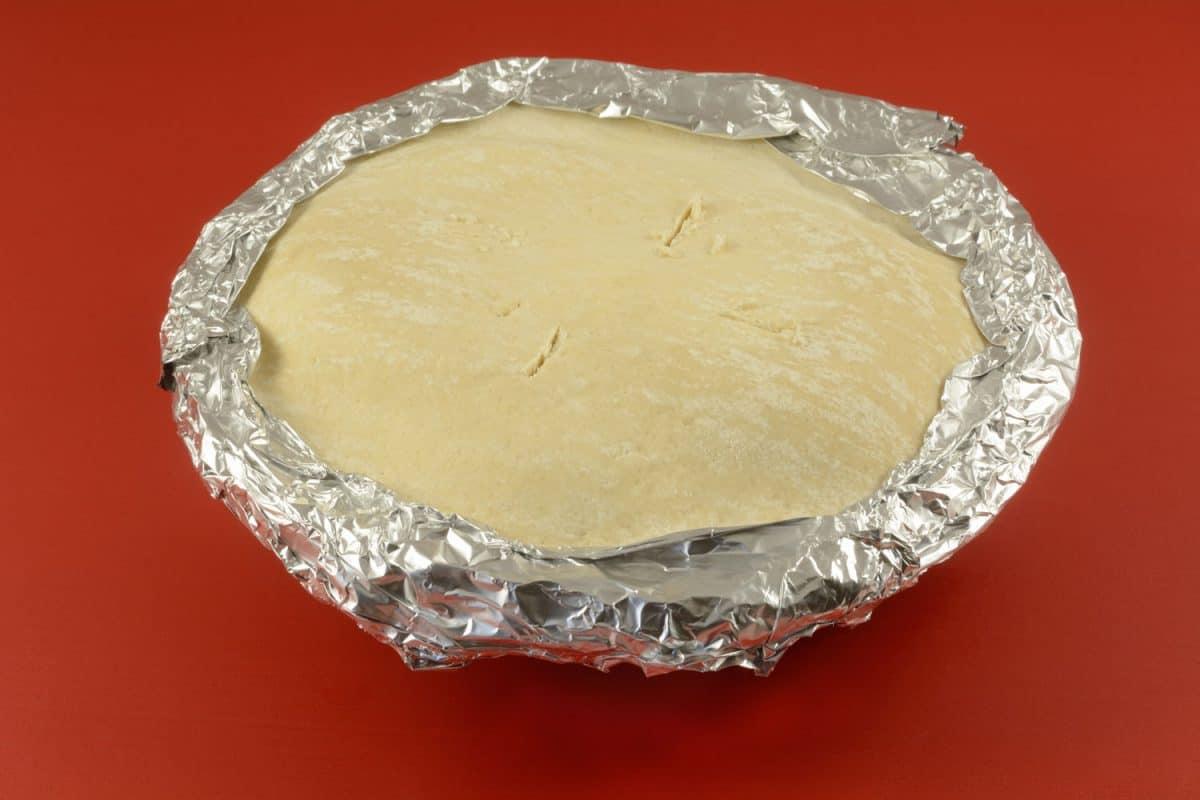
You can either purchase a pie shield, which is silicone-based, or you can create your own using aluminum foil. You can press pieces of foil around the edge, or you can cut a ring by snipping the middle out of a round piece of foil.
Click here to see this pie shield on Amazon.
How do I Know when my Pie Crust is Done?
You will be able to tell when your pie crust is done by taking a look at its appearance. It will be ready when it is golden brown in color throughout the entire crust. If your edges start to brown before the rest of your pie, use a pie shield to cover the pie crust until it is uniform in color. Baking your pie in a glass pie dish will allow you to take a look at the entire crust while it is baking.
And, if you're wondering how deep a pie dish is, take a look at the answer here: How Deep Is A Pie Pan? [Inc. Deep Dish]
Fruit Filled
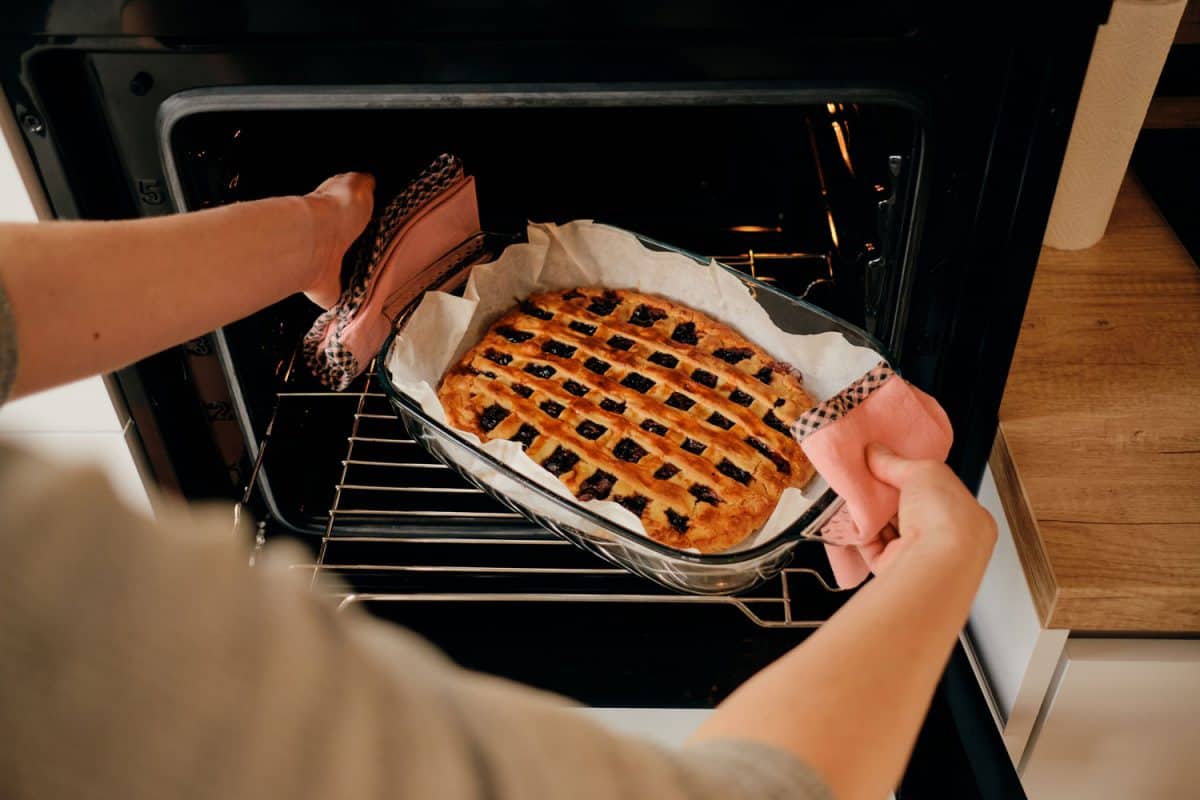
When you bake a fruit pie, it's hard to tell if the pastry is baked all the way through underneath. You can use the filling as an indicator as to whether the pie is done.
If you are baking a fruit-filled pie, your crust is done when the pastry is brown, and the fruit filling is bubbling up through the vents you made on the top of your pie. We recommend letting the filling bubble for at least five minutes before removing it from the oven.
Final Thoughts
Hopefully, our article has helped explain what temperature you should bake your pie at, depending on which method you choose. Furthermore, we hope it has helped you understand why some recipes call for higher baking temperatures and shorter bake times and vice versa. With a little practice and experimentation, you should have the perfect pie crust in no time! Happy Baking!
For more reading, check out some of our other blog posts:
Does Apple Pie Need A Top Crust?
How To Put Dough In A Pie Pan [A Complete Guide]




![A woman making a delicious pie in her kitchen, How To Put Dough In A Pie Pan [A Complete Guide]](https://kitchenseer.com/wp-content/uploads/2021/08/A-woman-making-a-delicious-pie-in-her-kitchen-250x250.jpg)
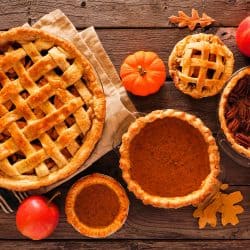

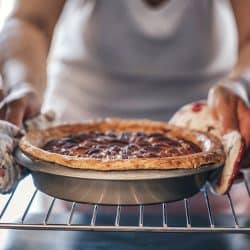
![Cinnamon and apple lattice puff pastry cake - How Many Layers In Puff [And How To Make One]](https://kitchenseer.com/wp-content/uploads/2022/05/Cinnamon-and-apple-lattice-puff-pastry-cake-250x250.jpg)